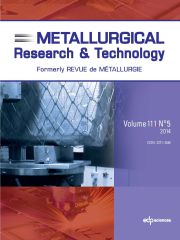Crossref Citations
This article has been cited by the following publications. This list is generated based on data provided by
Crossref.
Simon, Bálint
Ziemann, Saskia
and
Weil, Marcel
2015.
Potential metal requirement of active materials in lithium-ion battery cells of electric vehicles and its impact on reserves: Focus on Europe.
Resources, Conservation and Recycling,
Vol. 104,
Issue. ,
p.
300.
Troy, Stefanie
Schreiber, Andrea
Reppert, Thorsten
Gehrke, Hans-Gregor
Finsterbusch, Martin
Uhlenbruck, Sven
and
Stenzel, Peter
2016.
Life Cycle Assessment and resource analysis of all-solid-state batteries.
Applied Energy,
Vol. 169,
Issue. ,
p.
757.
Helbig, Christoph
Wietschel, Lars
Thorenz, Andrea
and
Tuma, Axel
2016.
How to evaluate raw material vulnerability - An overview.
Resources Policy,
Vol. 48,
Issue. ,
p.
13.
Nansai, Keisuke
Nakajima, Kenichi
Suh, Sangwon
Kagawa, Shigemi
Kondo, Yasushi
Takayanagi, Wataru
and
Shigetomi, Yosuke
2017.
The role of primary processing in the supply risks of critical metals.
Economic Systems Research,
Vol. 29,
Issue. 3,
p.
335.
Versteeg, T.
Baumann, M.J.
Weil, M.
and
Moniz, A.B.
2017.
Exploring emerging battery technology for grid-connected energy storage with Constructive Technology Assessment.
Technological Forecasting and Social Change,
Vol. 115,
Issue. ,
p.
99.
Ziemann, Saskia
Rat-Fischer, Christoph
Müller, Daniel B.
Schebek, Liselotte
Peters, Jens
and
Weil, Marcel
2017.
A critical analysis of material demand and recycling options of electric vehicles in sustainable cities.
Matériaux & Techniques,
Vol. 105,
Issue. 5-6,
p.
515.
Ziemann, Saskia
Müller, Daniel B.
Schebek, Liselotte
and
Weil, Marcel
2018.
Modeling the potential impact of lithium recycling from EV batteries on lithium demand: A dynamic MFA approach.
Resources, Conservation and Recycling,
Vol. 133,
Issue. ,
p.
76.
Terlouw, Tom
Zhang, Xiaojin
Bauer, Christian
and
Alskaif, Tarek
2019.
Towards the determination of metal criticality in home-based battery systems using a Life Cycle Assessment approach.
Journal of Cleaner Production,
Vol. 221,
Issue. ,
p.
667.
Liu, Donghui
Gao, Xiangyun
An, Haizhong
Qi, Yabin
Sun, Xiaoqi
Wang, Ze
Chen, Zhihua
An, Feng
and
Jia, Nanfei
2019.
Supply and demand response trends of lithium resources driven by the demand of emerging renewable energy technologies in China.
Resources, Conservation and Recycling,
Vol. 145,
Issue. ,
p.
311.
Kim, Juhan
Lee, Jungbae
Kim, BumChoong
and
Kim, Jinsoo
2019.
Raw material criticality assessment with weighted indicators: An application of fuzzy analytic hierarchy process.
Resources Policy,
Vol. 60,
Issue. ,
p.
225.
Ortego, Abel
Calvo, Guiomar
Valero, Alicia
Iglesias-Émbil, Marta
Valero, Antonio
and
Villacampa, Mar
2020.
Assessment of strategic raw materials in the automobile sector.
Resources, Conservation and Recycling,
Vol. 161,
Issue. ,
p.
104968.
Schwich, Lilian
Küpers, Michael
Finsterbusch, Martin
Schreiber, Andrea
Fattakhova-Rohlfing, Dina
Guillon, Olivier
and
Friedrich, Bernd
2020.
Recycling Strategies for Ceramic All-Solid-State Batteries—Part I: Study on Possible Treatments in Contrast to Li-Ion Battery Recycling.
Metals,
Vol. 10,
Issue. 11,
p.
1523.
Kiemel, Steffen
Glöser-Chahoud, Simon
Waltersmann, Lara
Schutzbach, Maximilian
Sauer, Alexander
and
Miehe, Robert
2021.
Assessing the Application-Specific Substitutability of Lithium-Ion Battery Cathode Chemistries Based on Material Criticality, Performance, and Price.
Resources,
Vol. 10,
Issue. 9,
p.
87.
Helbig, Christoph
Bruckler, Martin
Thorenz, Andrea
and
Tuma, Axel
2021.
An Overview of Indicator Choice and Normalization in Raw Material Supply Risk Assessments.
Resources,
Vol. 10,
Issue. 8,
p.
79.
Qiao, Donghai
Wang, Gaoshang
Gao, Tianming
Wen, Bojie
and
Dai, Tao
2021.
Potential impact of the end-of-life batteries recycling of electric vehicles on lithium demand in China: 2010–2050.
Science of The Total Environment,
Vol. 764,
Issue. ,
p.
142835.
Bongartz, Lisa
Shammugam, Shivenes
Gervais, Estelle
and
Schlegl, Thomas
2021.
Multidimensional criticality assessment of metal requirements for lithium-ion batteries in electric vehicles and stationary storage applications in Germany by 2050.
Journal of Cleaner Production,
Vol. 292,
Issue. ,
p.
126056.

